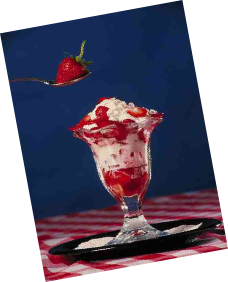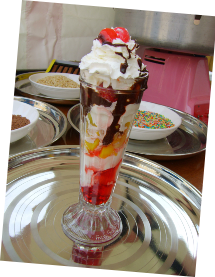SUNDAE BAR AND WEDDING ICE CREAM BUFFET INFORMATION
ICE CREAM SUNDAE DISHES
The sundae is an ice cream dessert. It typically consists of a soft ice cream topped
with sauce or syrup, and in some cases other toppings including chopped nuts, whipped
cream or maraschino cherries.
History and Controversy
According to the Oxford English Dictionary, the origin of the term sundae is obscure.
Various American localities have claimed to be the birthplace of the ice cream sundae.
These claimants include Ithaca, New York; Two Rivers, Wisconsin; Plainfield, Illinois;
Evanston, Illinios; New York City; New Orleans, Louisiana; Cleveland, Ohio; and Buffalo,
New York.
There is debate between Ithaca and Two Rivers over which city has the right to claim
the title "birthplace of the ice cream sundae." When Ithaca mayor Carolyn Peterson
proclaimed a day to celebrate her city as the birthplace of the sundae, she received
postcards from Two Rivers' citizens reiterating that town's claim.
Of the many stories about the invention of the sundae, one frequent theme is the
sinfulness of the Ice Cream Soda and the need to produce a substitute for the popular
treat for consumption on Sunday. Peter Bird writes in The First Food Empire (2000)
that the name 'sundae' was adopted from Illinois state's early prohibition of ice
cream consumption on Sundays, because ice cream with a topping that obscured the
main product was not deemed to be ice cream.
Ithaca, New York in 1892
Supporting Ithaca's claim, researchers at The History Center in Tompkins County,
New York, provide an account of how the sundae came to be: On Sunday, April 3, 1892
in Ithaca, John M. Scott, a Unitarian Church minister, and Chester Platt, co-owner
of Platt & Colt Pharmacy, created the first historically documented sundae. Platt
covered dishes of ice cream with cherry syrup and candied cherries on a whim. The
men named the dish "Cherry Sunday" in honour of the day it was created. The oldest-known
written evidence of a sundae is Platt & Colt's newspaper ad for a "Cherry Sunday"
placed in the Ithaca Daily Journal on April 5, 1892. By May, 1892, the Platt & Colt
soda fountain also served "Strawberry Sundays," and later, "Chocolate Sundays." Platt
& Colt's "Sundays" grew so popular that by 1894, Chester Platt attempted to trademark
the term ice cream "Sunday.
Evanston, Illinois in 1890
Evanston was one of the first locations to pass a Blue Law against selling ice cream
sodas in 1890. "Some ingenious confectioners and drug store operators [in Evanston]...
obeying the law, served ice cream with the syrup of your choice without the soda.
Thereby complying with the law ... This sodaless soda was the Sunday soda. As sales
of the dessert continued on Mondays, local leaders then objected to naming the dish
after the Sabbath. So the spelling of the name was changed to Sundae.
Two Rivers, Wisconsin in 1899
Two Rivers' claim is based on the story of George Hallauer asking Edward C. Berners,
the owner of Berners' Soda Fountain, to drizzle chocolate syrup over ice cream in
1881. Berners eventually did and wound up selling the treat for a nickel, originally
only on Sundays, but later every day. According to this story, the spelling changed
when a glass salesman ordered canoe-shaped dishes. When Berners died in 1939, the
Chicago Tribune headlined his obituary "Man Who Made First Ice Cream Sundae Is Dead.
Two Ithaca High School students, however, claim that Berners would have only been
16 or 17 in 1881 and it is therefore "improbable" that he would have owned an ice
cream shop in that year. They also state that the obituary dates Berners' first sundae
to 1899 rather than 1881.
Strawberry sundae
A Classic sundae which is created using vanilla ice cream, Strawberrye sauce, whipped
cream, nuts, and a single bright-red maraschino cherry on top.
Hot fudge sundae
The classic hot fudge sundae is often a creation of vanilla ice cream, hot chocolate
sauce (hence the "hot fudge"), whipped cream, nuts, and a single bright-red maraschino
cherry on top. A hot fudge sundae can be made with any flavour of ice cream.
Turtle sundae
The popular combination of vanilla ice cream, hot fudge and caramel sauces, and toasted
pecans is known as a turtle sundae.
Black & White
This sundae features a scoop of vanilla ice cream with chocolate sauce and a scoop
of chocolate ice cream with marshmallow topping.
Brownie sundae
A rich sundae made with brownies, vanilla ice cream, chocolate syrup, peanuts, hot
fudge, and whipped cream, often topped with a single bright-red maraschino cherry.
Banana split
Three sundaes in one, side by side between two halves of a banana, sliced lengthwise.
Includes strawberry ice cream topped with strawberry syrup, chocolate ice cream topped
with chocolate syrup, and vanilla ice cream topped with crushed pineapple. Each scoop
is individually garnished with whipped cream and a cherry.
Bananas Foster
This is a sundae that features a flambé of bananas with rum, banana liquor and spices.
American Parfait
This is a sundae served in a tall glass filled with layers of ice cream and flavourings,
such as granola, syrups or liqueurs.
Knickerbocker Glory
A knickerbocker glory is an ice cream sundae that is served in a large tall glass,
particularly in the United Kindom. In the United States, the closest equivalent would
be a Parfait or a trifle.
The knickerbocker glory was first described in the 1930s and contains ice cream,
fruit (jelly) and cream. Layers of these different sweet tastes are alternated in
a tall glass and topped with different kinds of syrup, nuts, whipped cream and often
a cherry. Layers of meringue, fruit and even alcohol may be included but, as with
an ice cream sundae, there is no precise recipe.
The name knickerbocker glory is drawn from knickerbockers, a type of long trouser
traditionally worn by young children (but particularly young boys).


